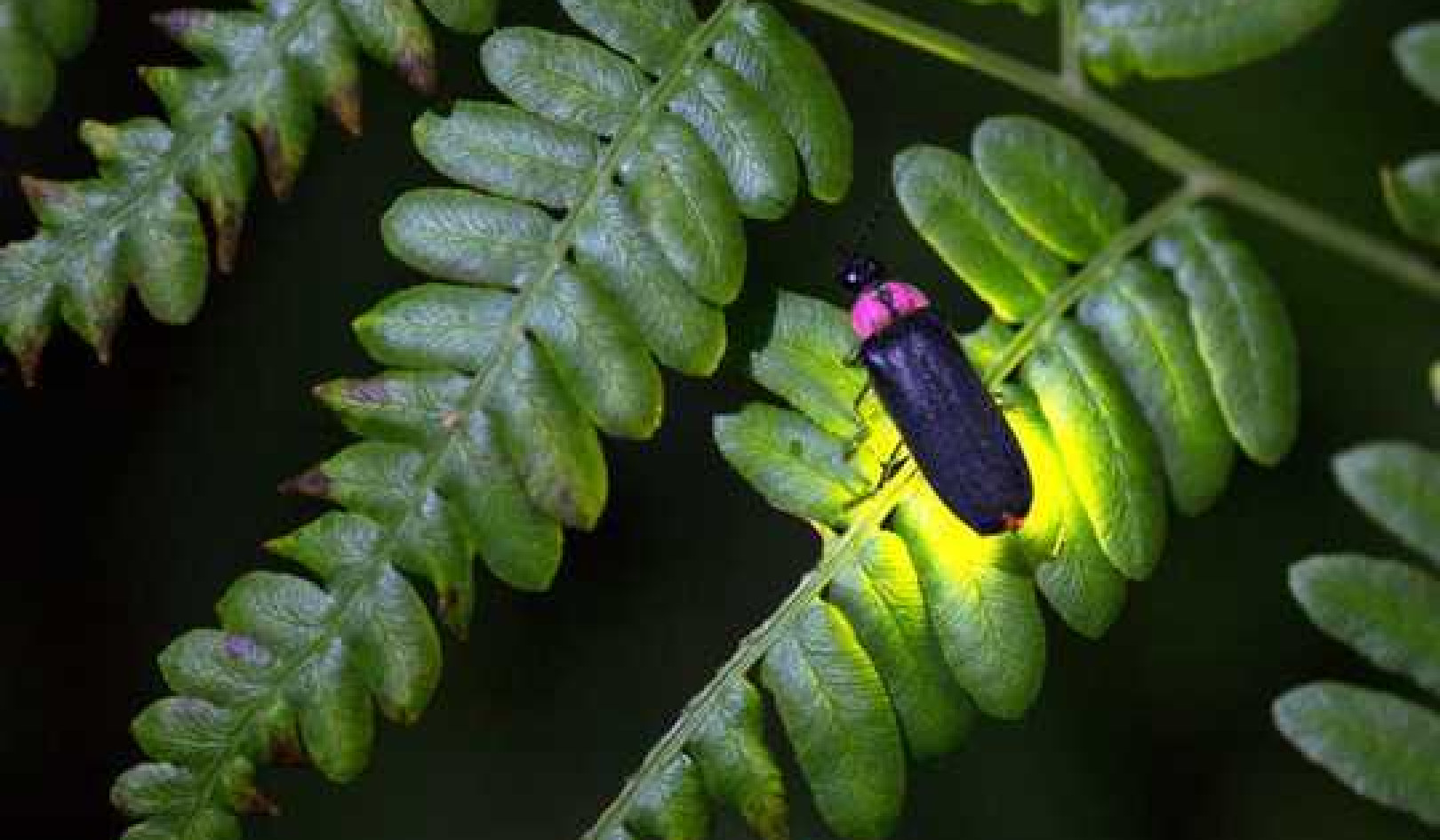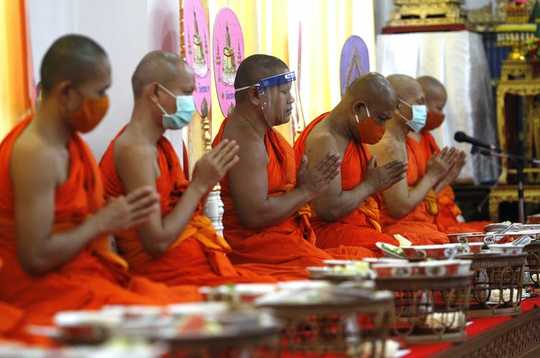 Buddhist monks in Thailand pray at Phleng temple amid the COVID-19 crisis, May 11, 2020. Chaiwat Subprasom/SOPA Images/LightRocket via Getty Images
Buddhist monks in Thailand pray at Phleng temple amid the COVID-19 crisis, May 11, 2020. Chaiwat Subprasom/SOPA Images/LightRocket via Getty Images
Millions of Buddhists seeking protection and healing from the novel coronavirus are turning to traditional religious rituals.
Since the emergence of COVID-19, the Dalai Lama, other senior monks and Buddhist organizations in Asia and worldwide have emphasized that this pandemic calls for meditation, compassion, generosity and gratitude. Such messages reinforce a common view in the West of Buddhism as more philosophy than religion – a spiritual, perhaps, but secular practice associated with mindfulness, happiness and stress reduction.
But for many people around the world Buddhism is a religion – a belief system that includes strong faith in supernatural powers. As such, Buddhism has a large repertoire of healing rituals that go well beyond meditation.
Having studied the interplay between Buddhism and medicine as a historian and ethnographer for the past 25 years, I have been documenting the role these ritual practices play in the coronavirus pandemic.
Talismans, prayer and ritual
Buddhism originated in India about two and a half millennia ago. Today, with well over a half-billion adherents across the world, it is a highly diverse tradition that has adapted to many cultural and social contexts.
There are three main schools of traditional Buddhism: Therav?da, practiced in most of Southeast Asia; Mah?y?na, the form most prevalent in East Asia; and Vajray?na, commonly associated with Tibet and the Himalayan region.
In Buddhist-majority places, the official COVID-19 pandemic response includes conventional emergency health and sanitation measures like recommending face masks, hand-washing and stay-at-home orders. But within religious communities, Buddhist leaders also are using a range of ritual apotropaics – magical protection rites – to protect against disease.
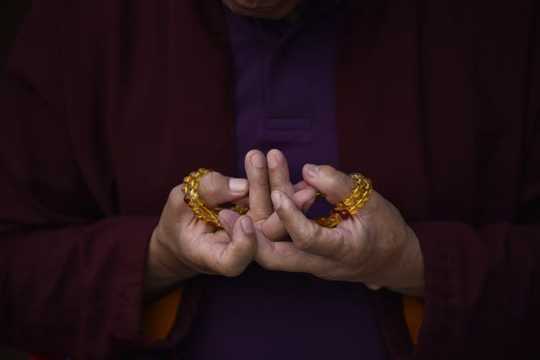 A Nepalese Buddhist monk offering ritual prayer, May 7, 2020. Narayan Maharjan/NurPhoto via Getty Images
A Nepalese Buddhist monk offering ritual prayer, May 7, 2020. Narayan Maharjan/NurPhoto via Getty Images
In Thailand, for example, Therav?da temples are handing out “yant,” talismans bearing images of spirits, sacred syllables and Buddhist symbols. These blessed orange papers are a common ritual object among Buddhists in Southeast Asia who see crises such as epidemic illnesses as a sign that demonic forces are on the rise.
Therav?da amulets and charms trace their magical powers to repel evil spirits not only to the Buddha but also to beneficial nature spirits, demigods, charismatic monks and wizards.
Now, these blessed objects are being specifically formulated with the intention of protecting people from contracting the coronavirus.
Mah?y?na Buddhists use similar sacred objects, but they also pray to a whole pantheon of buddhas and bodhisattvas – another class of enlightened beings – for protection. In Japan, for example, Buddhist organizations have been conducting expulsion rites that call on Buddhist deities to help rid the land of the coronavirus.
Mah?y?na practitioners have faith that the blessings bestowed by these deities can be transmitted through statues or images. In a modern twist on this ancient belief, a priest affiliated with the T?daiji temple in Nara, Japan, in April tweeted a photo of the great Vairocana Buddha. He said the image would protect all who lay eyes upon it.
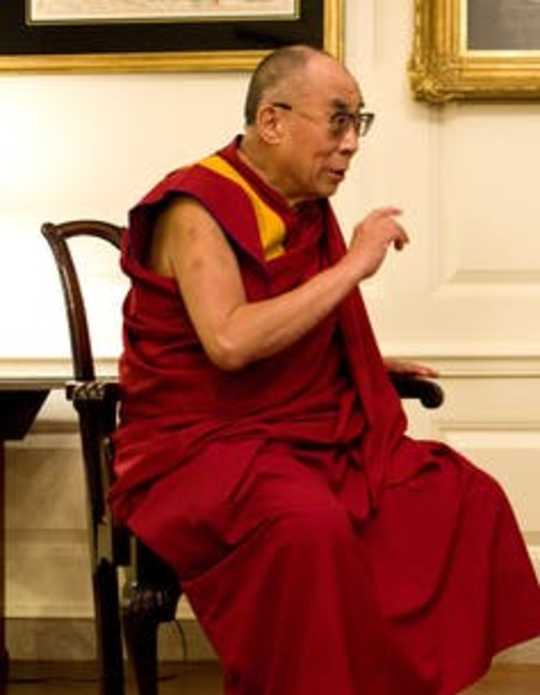 The Dalai Lama, the Buddhist spiritual leader of the Tibetan people. Pixabay
The Dalai Lama, the Buddhist spiritual leader of the Tibetan people. Pixabay
The third major form of Buddhism, Vajray?na, which developed in the medieval period and is widely influential in Tibet, incorporates many rituals of earlier traditions. For example, the Dalai Lama has urged practitioners in Tibet and China to chant mantras to the bodhisattva T?r?, a female goddess associated with compassion and well-being, to gain her protection.
Vajray?na practitioners also advocate a unique form of visualization where the practitioner generates a vivid mental image of a deity and then interacts with them on the level of subtle energy. Responses to COVID-19 suggested by leading figures in traditional Tibetan medicine frequently involve this kind of visualization practice.
Buddhist modernism
Since the height of the colonial period in the 19th century, “Buddhist modernists” have carefully constructed an international image of Buddhism as a philosophy or a psychology. In emphasizing its compatibility with empiricism and scientific objectivity they have ensured Buddhism’s place in the modern world and paved the way for its popularity outside of Asia.
Many of these secular-minded Buddhists have dismissed rituals and other aspects of traditional Buddhism as “hocus pocus” lurking on the fringes of the tradition.
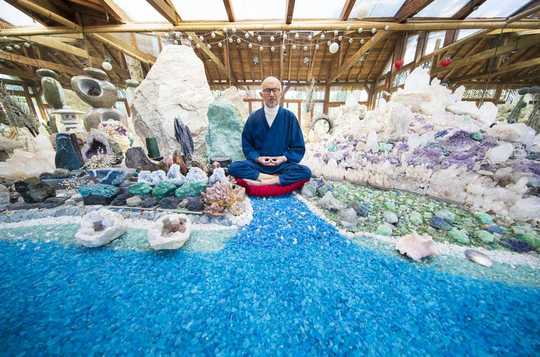 A former Buddhist monk practices visualization meditation during the coronavirus crisis, April 24, 2020. Danny Lawson/PA Images via Getty Images
A former Buddhist monk practices visualization meditation during the coronavirus crisis, April 24, 2020. Danny Lawson/PA Images via Getty Images
Having documented the richness of the history and contemporary practice of Buddhist healing and protective rituals, however, I argue that these practices cannot be written off quite so easily.
In most living traditions of Buddhism, protective and healing rituals are taken seriously. They have sophisticated doctrinal justifications that often focus on the healing power of belief.
Increasingly, researchers are agreeing that faith in itself plays a role in promoting health. The anthropologist Daniel Moerman, for example, has identified what he calls the “meaning response.” This model accounts for how cultural and social beliefs and practices lead to “real improvements in human well-being.” Likewise, Harvard Medical School researcher Ted Kaptchuk has studied the neurobiological mechanisms for how rituals work to alleviate illnesses.
To date, there is no known way to prevent COVID-19 other than staying home to avoid contagion, and no miracle cure. But for millions worldwide, Buddhist talismans, prayers and protective rituals offer a meaningful way to confront the anxieties of the global coronavirus pandemic, providing comfort and relief.
And in a difficult time when both are in short supply, that’s nothing to discredit.
About The Author
Pierce Salguero, Associate Professor of Asian History & Religious Studies, Pennsylvania State University
This article is republished from The Conversation under a Creative Commons license. Read the original article.
Related Books:
The Body Keeps the Score: Brain Mind and Body in the Healing of Trauma
by Bessel van der Kolk
This book explores the connections between trauma and physical and mental health, offering insights and strategies for healing and recovery.
Click for more info or to order
Breath: The New Science of a Lost Art
by James Nestor
This book explores the science and practice of breathing, offering insights and techniques for improving physical and mental health.
Click for more info or to order
The Plant Paradox: The Hidden Dangers in "Healthy" Foods That Cause Disease and Weight Gain
by Steven R. Gundry
This book explores the links between diet, health, and disease, offering insights and strategies for improving overall health and wellness.
Click for more info or to order
The Immunity Code: The New Paradigm for Real Health and Radical Anti-Aging
by Joel Greene
This book offers a new perspective on health and immunity, drawing on principles of epigenetics and offering insights and strategies for optimizing health and aging.
Click for more info or to order
The Complete Guide to Fasting: Heal Your Body Through Intermittent, Alternate-Day, and Extended Fasting
by Dr. Jason Fung and Jimmy Moore
This book explores the science and practice of fasting offering insights and strategies for improving overall health and wellness.
Click for more info or to order




















